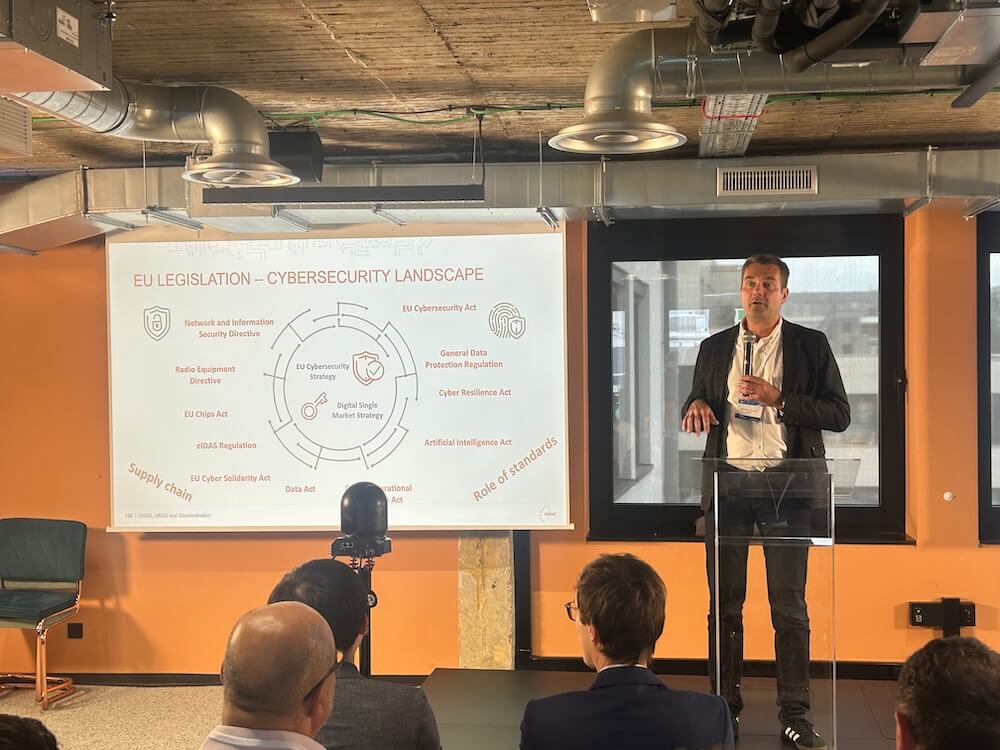GlobalPlatform Brings Together Key Stakeholders To Discuss EU Digital ID Wallet, Setting a Roadmap for Europe’s Digital Identity Future
Download the presentation slides from this seminar.
Europe’s plan to launch a cross-border digital identity scheme is reaching a critical stage. The European Union Digital ID Wallet (EUDI) is on track to be available to all EU citizens by 2026, and many national schemes and trials are already underway. But there is still much work to do to get the necessary technical requirements, certification processes, and governance structures in place.
That’s why we brought together EU officials, representatives from EU Member States, device manufacturers, cybersecurity experts, and other stakeholders in Brussels last week for our second GlobalPlatform eID Wallet Seminar. It served as a unique opportunity to strengthen collaboration on EUDI initiatives and accelerate the technical roadmap.
The seminar began with a welcome and introduction by GlobalPlatform Chair, Stephanie El Rhomri, highlighting the role GlobalPlatform has played in developing the foundation of security across various industries for over 25 years including an overview of secure components, GlobalPlatfform’s certification program and SESIP. She also discussed the importance of security and privacy for digital identity wallets, outlining GlobalPlatform’s commitment to working with industry stakeholders and government regulators in preparing for the deployment of the EUDI.
The eID Wallet Seminar included keynote addresses from:
Vedran Lalic, Former Head of MEP’s Office at the European Parliament

Vedran Lalic played a leading role in ratifying the eIDAS 2.0 regulation that will bring the EUDI to market. He described the scheme as a “transformative milestone in the European journey” that will drive inclusion and economic growth across the Member States, creating a truly single market for citizens.
Lalic called for a pan-European approach to implementing EUDI that prioritizes interoperability and security. He stressed that this needs to be based on Secure Element technologies and widespread collaboration between industries.
“EUDI is not just a technical tool. It is a symbol of Europe’s commitment to privacy and empowerment of its citizens,” he concluded. “It will set a global standard.”
Jean Daniel Aussel, Head of Standardization, Thales Digital Identity and Security

As Chair of the eID Wallet Task Force at GlobalPlatform, Jean Daniel Aussel addressed the challenges in bringing certified tamper-proof solutions to the Wallet environment – and the need for balancing security with the need to deploy fast.
He highlighted how the Wallet Cryptographic Secure Device (WSCD) must be a hardware device certified with Common Criteria methodology at EAL4+ AVA_VAN.5 to provide the foundation for the Wallet to have a high level of assurance – noting that this is the only way to defend against attackers with high attack potential.
Aussel said that several methods for delivering this level of security could co-exist over time. But he added that the embedded Secure Element already offered significant advantages due to its huge reach, with almost 500 million eSIM smartphones expected to be shipped in Europe in 2028. “Using embedded Secure Elements inside the smartphone is a matter of business agreements and governance, not a technological issue,” he stated.
Sławomir Górniak, Senior Cybersecurity Expert, ENISA

Sławomir Górniak addressed the role of the EU Agency for Cybersecurity (ENISA) in setting a certification framework for the introduction of EUDI Wallets, building on the various regulations within the EU Cybersecurity Act. “Regulations are not an island and we’re building an ecosystem with all these acts interlinked,” he said.
Górniak previewed the upcoming Implementing Acts for EUDI, but also voiced support for providing harmonized certification requirements for national schemes. “We’re looking at what’s going on in the Member States to see who is doing what, but we want to prevent big discrepancies between schemes,” he said.
Attendees gained expert insights from several other organizations leading the development of EUDI, including:
France Titres (ANTS) – Anthony Carmoy provided an update on the current eID card in France, which is now being used by 1.2 million citizens. The card was used as a proxy for the recent European elections – its first real-life use case for high Level of Assurance (LoA).
German Federal Agency for Disruptive Innovation (SPRIN-D) – Torsten Lodderstedt updated attendees on Germany’s plans to introduce a government-provided Wallet by the end of 2026 and plans to deploy six Wallet use cases via an innovation competition.
GlobalPlatform – CTO Gil Bernabeu provided an overview of new solutions designed to accelerate and simplify adoption of EUDI, including Secure Applications for Mobile (SAM) and the Cryptographic Service Provider (CSP).
iDAKTO – Yann Bouan offered the view on EUDI from the wallet platform provider’s perspective. Building on the company’s experience in delivering the French eID scheme, Bouan outlined the company’s vision for wallets that were multi-standard and modular – without the need to delay waiting for “one standard to rule them all.”
Samsung – Dawid Wroblewski of Digital Identity Samsung discussed the EUDI Wallet from the device manufacturer’s perspective. He outlined how Samsung Knox technology was built on the Secure Element and how the current Samsung Wallet could be combined with EUDI.
Visa – Laurent Bailly shared findings from the EU Digital Wallet Consortium (EWC)’s large-scale pilot focused on payments. This included using EUDI as an alternative authentication method for online payments and as a Wallet for holding payment credentials
Bringing the ecosystem together
Hundreds of participants attended the one-day event both in-person and online, joining panel sessions zeroing in on specific topics such as ecosystem development and certification schemes. Many also took part in a two-day training session prior to the seminar focused on how Secure Element technologies can be optimized for EUDI Wallet schemes.
The event set the stage for a pivotal year in the EU’s quest to build a new digital ecosystem across Europe based on secure technologies.

